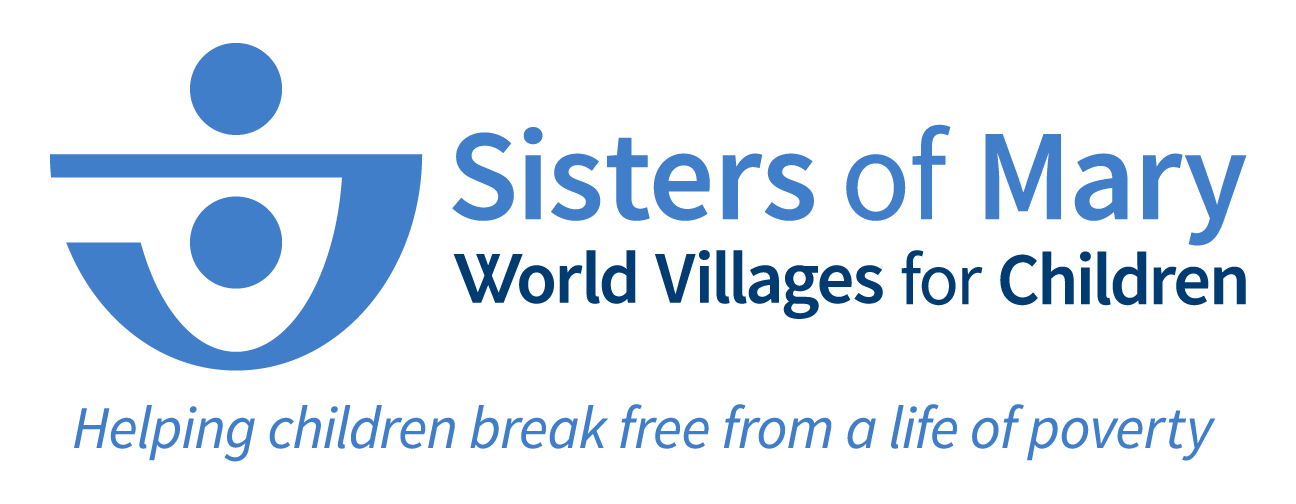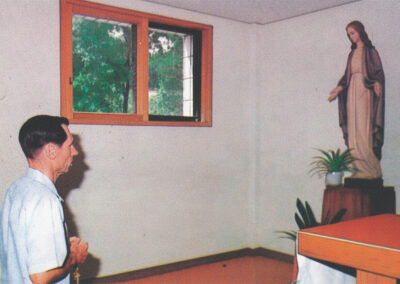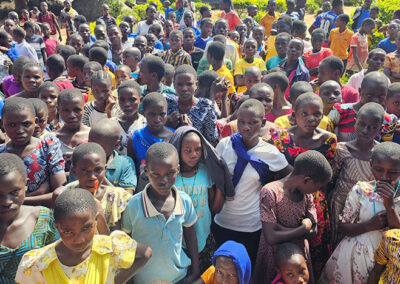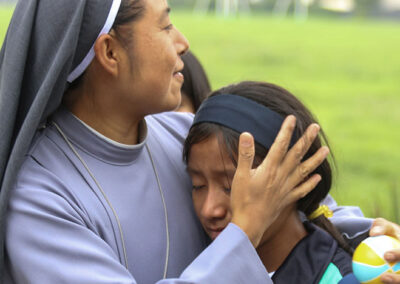“Non sum ego eram”- I am not that I was
Fr. Bob Golas had been a priest for nearly two decades in the Archdiocese of Washington when something foreign – something uncontrollable – began to materialize in his body this past winter. It came on abruptly. Those in his presence observed it but out of courtesy stayed quiet.
While at prayer, in the middle of conversations with parishioners, and occasionally while presiding at Masses at Holy Redeemer in College Park, Md., he found himself on the verge of tears. He choked up in the middle of announcements and homilies. Sometimes he just let the tears run down his cheeks. It was a phenomenon. Never before had he experienced anything like it.
All of this has made Holy Week all the more significant.
“Non sum ego eram,” said Fr. Golas after celebrating Mass at his parish recently. “The Latin phrase keeps running through my head. I am not that I was. … I was invited to Girlstown in Chalco and it was there that I found myself falling in love with a dead priest, and it began to affect me deeply.
“I came to know Venerable Aloysius Schwartz. His heroism and abandonment to God truly shook me – and really, I’ve found myself emotional since. … Fr. Al basically showed me, and everyone that heard and knew him, that until we understood Jesus in the poor, that part of our lives would be stunted. And mine was stunted. I think I was doing the best I could as a priest, but really, Fr. Al showed me that I was partially going through the motions. Fr. Al was a priest who poured all of himself out for the poor.”
The Saving Grounds of Villa de Las Niñas
As he traveled by plane to Mexico City, Fr. Golas began to thumb through the pages of Fr. Al’s biography, Priest and Beggar: The Heroic Life of Venerable Aloysius Schwartz, and soon found that he couldn’t put it down. Thereafter, he observed the work of the Sisters of Mary and chaplain Fr. Dan Leary, who he perceived as tireless workers bringing about healing in places of deep brokenness. Fr. Golas saw that the Girlstown community of Villa de Las Niñas was a saving ground, acres and acres of an old carrot farm now covered in God’s sacred graces, goodwill, and spiritual rebirth.
In a sense, Fr. Golas climbed a mountain in Chalco and became transfigured. What happened so powerfully for the priest in the community of Villa de Las Niñas?
After passing through the iron gates and past the high stone walls of Girlstown, he entered what he soon regarded as an ordered place of joy. But as the week progressed, he began to view the community as a miraculous valley of risen Lazaruses. He was confronted by enormous shafts of teenage Catholic light. He saw a Girlstown community of 3,045 teenage girls who appeared to him as choruses of startlingly radiant angels.
The American priest was told of the shadows that lurked outside the walls. These were the same girls who had entered the five-year school having endured unspeakable wounds.
In many of the villages outside of the Girlstown community are the human traffickers, drug runners, and gang members who the soul-bruised teenage girls managed to escape. Many of the teenage boys and girls in Boystown and Girlstown communities – in fifteen different locations throughout the world – have endured unimaginable pain in navigating the dysfunctionality, terror, and violence of drug- and alcohol-fueled poverty.
“The children suffered, but I saw the poor being greatly loved by Fr. Dan and the Sisters of Mary. They see Christ in them and work their hardest for them every day,” Fr. Golas said. “I’ve always loved the spirituality in Eastern orthodox rite of the Church. I appreciate the asceticism, the mystical, the monastic life, their rituals, and sacred artwork – but then I saw the work that Fr. Al Schwartz created, I ask myself, ‘How did I miss this?’
“These poor girls were Jesus Christ. Jesus made it clear in the Gospel. And Fr. Al understood this ‘Jesus in the poor’ better than most … I needed to experience that. Now, I feel like I need to go back every year to get away from the ever-running river of American consumerism and culture. It doesn’t really stop here, but it does in Girlstown.”
The children in these communities do not have cell phones or earbuds, they do not play video games or browse social media. Consequently, they have more time to hone their God-given skills. This was Fr. Al’s pared-down “way.” His desire was for children to have time to pray, play and pursue holiness.
“Fr. Al was a superhero”
“Fr. Al,” as he is known in these parts, died at the age of 62 from amyotrophic lateral sclerosis, (ALS) Lou Gehrig’s Disease. Prior to his death, the Washington, D.C. native fashioned one of the most remarkable non-governmentally-funded services to the poor in the history of the world, having begged for tens of millions of dollars to build hospitals, dormitories, tubercular wards, orphanages, gymnasiums, schools, and churches. His schematic, founded in Korea in 1964, would eventually pull nearly 170,000 children from abject poverty, many of whom lived in trash dumps with names like Smokey Mountain and Ragpickers Camp in Korea and the Philippines.
When he opened the doors to the Mexican poor in 1991, his body was already fading away in the grip of ALS. To Fr. Al, this suffering was no accident. He told the Sisters of Mary: “Our role is to mingle our blood with the blood of Christ,” he once said. “And to shed our blood with that of Christ to the poor. The way we serve is to have a constant crown of thorns.”
In the days and weeks following his trip, Fr. Golas remains overwhelmed by the enormity of Fr. Al’s spiritual and temporal work. With a heightened awareness of “Christ in the poor”, Fr. Golas returned to parish life and dived further into Fr. Al’s writings. He read his books, Poverty: Sign of the Times and The Starved and the Silent. He’s also been introduced to some of Fr. Al’s homilies and letters to the Sisters of Mary’s community.
“Fr. Al was a superhero; all of his power he received from the graces of God,” Fr. Golas said. “God built his strengths within him so he could perform the work. He emptied himself out for the poor, and the Holy Spirit filled him.”
Perhaps Fr. Golas’s most jarring realization in Chalco was his level of comfort as a priest. “I was shaken out of my slumber,” he said. “Academically, I knew, thought about, and helped the poor. But now I have been fully opened to their dignity and value. They are Jesus.”
Knowing the impact that Fr. Al and the experience that Girlstown had on his own priesthood, Fr. Golas has become a benefactor to the Sisters of Mary. He has since encouraged other priests in the Archdiocese of Washington – and outside the diocese – to commit to finding time to make the same pilgrimage.
Note: Sisters of Mary World Villages for Children is a non-profit organization that financially supports the Sisters of Mary as they help children break free from a life of poverty and lead them to Christ. WVC provides food, shelter, clothing, medical expenses, Catholic education, and vocational training to more than 20,000 children in Boystowns and Girlstowns in six different countries around the world. To donate to World Villages for Children, please go to worldvillages.org/poverty.





